Music Matters: SRX High Definition Vinyl
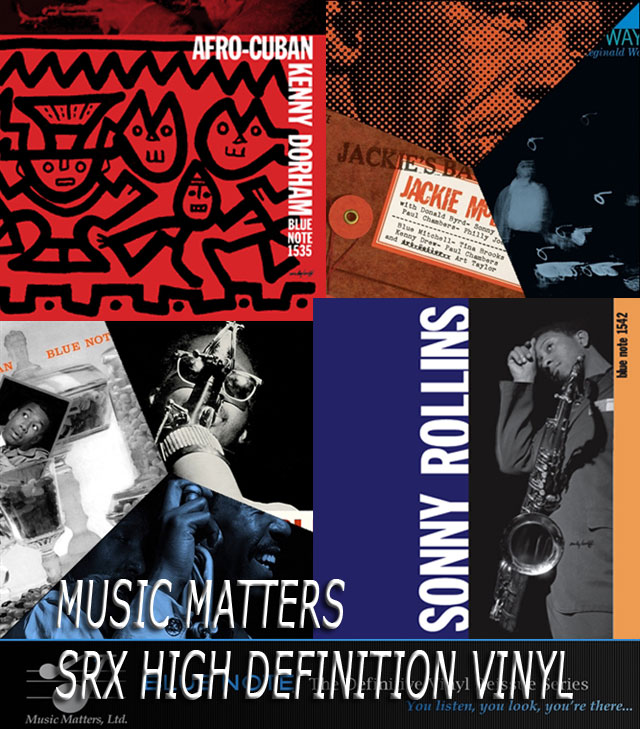
Quieter High-Def Vinyl
 A year ago, it seemed like premium reissue house Music Matters was wrapping itself up following one of the deepest surveys of the Blue Note catalog ever undertaken. But in what is surely welcome news to series fans, owner Ron Rambach will be releasing the first dozen titles in a new batch of Blue Note albums, which will be released on a new high-tech, high-resolution vinyl. The material, being called SRX Vinyl, is claimed to offer a quieter playing surface and higher resolution than previously available formulas. The plan calls for this group of twelve records, with an option for an additional dozen titles depending on sales – potentially twenty-four in total. Like the earlier series, the packaging will include premium heavyweight gatefold covers with rarely seen Francis Wolff session photos, and 180g records pressed by RTI. Unlike the previous series, all twelve titles will be released at once. Some popular titles are being re-done, as well as some great albums that weren’t released in either of Music Matters first two series. Rambach feels strongly that the new vinyl formulation yields significant sonic improvements.
A year ago, it seemed like premium reissue house Music Matters was wrapping itself up following one of the deepest surveys of the Blue Note catalog ever undertaken. But in what is surely welcome news to series fans, owner Ron Rambach will be releasing the first dozen titles in a new batch of Blue Note albums, which will be released on a new high-tech, high-resolution vinyl. The material, being called SRX Vinyl, is claimed to offer a quieter playing surface and higher resolution than previously available formulas. The plan calls for this group of twelve records, with an option for an additional dozen titles depending on sales – potentially twenty-four in total. Like the earlier series, the packaging will include premium heavyweight gatefold covers with rarely seen Francis Wolff session photos, and 180g records pressed by RTI. Unlike the previous series, all twelve titles will be released at once. Some popular titles are being re-done, as well as some great albums that weren’t released in either of Music Matters first two series. Rambach feels strongly that the new vinyl formulation yields significant sonic improvements.
.jpg?KeepThis=true&TB_iframe=true&height=430&width=700)
A Little Background Noise
 Music Matters went further into the Blue Note catalog to retrieve rarely heard sessions than any other reissue house. Each record was re-mastered directly from the original tapes in an all-analog signal chain to assure the highest fidelity sound. Ones and zeroes were strictly excluded. Lesser-known records received every bit as much attention as the big hits, even though it was clear at the outset that some of them wouldn’t move quickly. They put out records by John Jenkins, Grachan Moncur III and Louis Smith, right next to the big ones by Art Blakey, John Coltrane, and Lee Morgan. In one case, when the original releases didn’t align with a single-session tape, they made an educated curatorial decision, obtained a new catalog number, and dropped an album that had never been issued in the first place (though it should have been): Hank Mobley’s long overdue The Feelin’s Good.
Music Matters went further into the Blue Note catalog to retrieve rarely heard sessions than any other reissue house. Each record was re-mastered directly from the original tapes in an all-analog signal chain to assure the highest fidelity sound. Ones and zeroes were strictly excluded. Lesser-known records received every bit as much attention as the big hits, even though it was clear at the outset that some of them wouldn’t move quickly. They put out records by John Jenkins, Grachan Moncur III and Louis Smith, right next to the big ones by Art Blakey, John Coltrane, and Lee Morgan. In one case, when the original releases didn’t align with a single-session tape, they made an educated curatorial decision, obtained a new catalog number, and dropped an album that had never been issued in the first place (though it should have been): Hank Mobley’s long overdue The Feelin’s Good.
 This wasn’t simply reissuing records to sell them – although selling them was certainly necessary to keep going. Ron is passionate about the Blue Note catalog, unflinching in his positive opinion of the sessions, and almost evangelistic about encouraging people to listen to the music. He’s in the record business, but before that he was, and remains, a music fan, bringing enormous enthusiasm to the project.
This wasn’t simply reissuing records to sell them – although selling them was certainly necessary to keep going. Ron is passionate about the Blue Note catalog, unflinching in his positive opinion of the sessions, and almost evangelistic about encouraging people to listen to the music. He’s in the record business, but before that he was, and remains, a music fan, bringing enormous enthusiasm to the project.
With some relationship massaging by Michael Cuscuna, Ron had been fortunate enough to negotiate a once in a lifetime contract giving him almost unlimited access to the original Blue Note master tapes, something no one is likely to ever obtain again as Universal Music works to preserve the fragile, rapidly aging media. The original tapes were a requirement for an all-analog product and without them the series would never have happened. From Ron’s perspective there would have been no point to cutting these records from a secondary source, or heaven forbid, a digital one. They auditioned hundreds of tapes, identifying the best-preserved material and rejecting some that had deteriorated.
In the end, although it was ultimately an incomplete survey of the Blue Note catalog, it was still among the largest single-label reissues ever undertaken with well over one hundred titles pressed. Music Matters set a higher standard for itself for sound quality and premium packaging, and jazz fans benefited from it with every record.
But first, business
 As a venture, reissuing records is a balancing act and sometimes it’s a risky one. There are always deeper catalogue titles that could be pressed, but unless you’re anticipating bankruptcy as part of your business model a line has to be drawn between choosing great material and choosing records that will sell. That’s why Blue Trane gets reissued over and over while the master tape for Kenny Clark and Francy Boland’s The Golden 8 – a fantastic Music Matters title, by the way – sat, collecting dust for fifty years. Music Matters gets a lot of kudos for releasing some great but obscure titles, but at the end of a decade run, although he still had the contract with Universal to press more records, Rambach felt that they’d mined everything important that they could reasonably expect to release and still recoup their investment.
As a venture, reissuing records is a balancing act and sometimes it’s a risky one. There are always deeper catalogue titles that could be pressed, but unless you’re anticipating bankruptcy as part of your business model a line has to be drawn between choosing great material and choosing records that will sell. That’s why Blue Trane gets reissued over and over while the master tape for Kenny Clark and Francy Boland’s The Golden 8 – a fantastic Music Matters title, by the way – sat, collecting dust for fifty years. Music Matters gets a lot of kudos for releasing some great but obscure titles, but at the end of a decade run, although he still had the contract with Universal to press more records, Rambach felt that they’d mined everything important that they could reasonably expect to release and still recoup their investment.
So they stopped pressing records.
Series fans were disappointed, responding with online petitions for more titles and personal entreaties for unreleased favorites (I’m still waiting for One Flight Up, Ron). After all, there were some great records that didn’t make it, usually due to source degradation, occasionally over legal rights, and even a missing tape or two (Duke Pearson’s Wahoo! had been in the wrong box for fifty years). Last year, with over one hundred titles on the street, Music Matters released the last of the 33s, and that – as they say – was that.
Well, maybe not quite that.
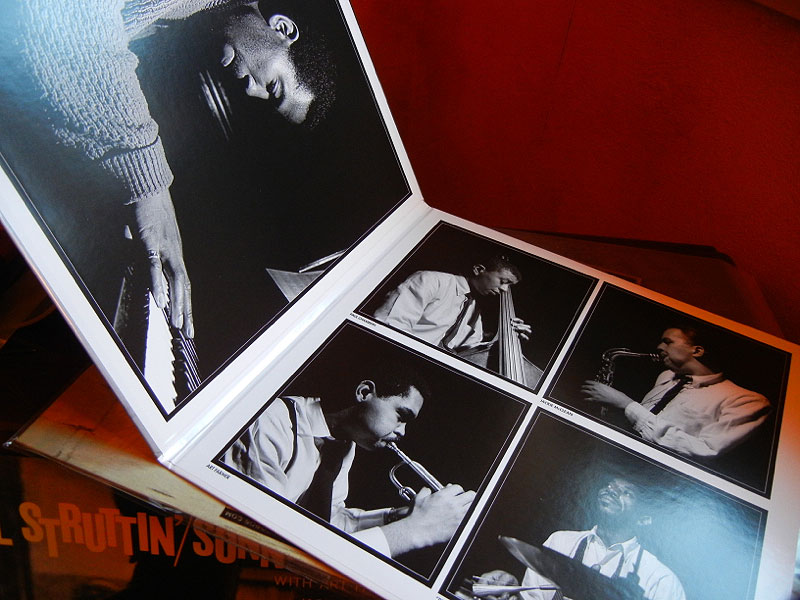
Messing With Perfection
The original two series from Music Matters – the 33s and the 45s – were very high-quality pressings. Rambach had an A-list team performing the remastering at Kevin Gray’s Cohearent Audio facility with production input from Joe Harley of AudioQuest. Between the three of them these guys have over a hundred years experience in the record business – long enough to have been there for vinyl’s heyday, its demise, and its recent resurrection. They know what they’re doing.
In remastering these records, the Music Matters team has – since the beginning – elected not to try to duplicate the exact sound of the original Blue Note records as originally cut by Rudy Van Gelder, preferring to let the tapes speak for themselves. When cutting his stampers, Van Gelder added elements of compression in some formula that he never divulged to anyone. By contrast, Music Matters chose to transfer the exact sound on the tapes as closely as possible without editorializing unless absolutely necessary to correct some sonic anomaly. As a result, the records have exceptional clarity and dynamics, but have also occasionally run into some criticism for not sounding exactly like the original pressings. Some people prefer the original sound, and that’s a personal preference, but for the rest of us the Music Matters pressings – any of them – offer very-high quality sonic reproduction, even if the records don’t have the exact acoustic signature of the originals.
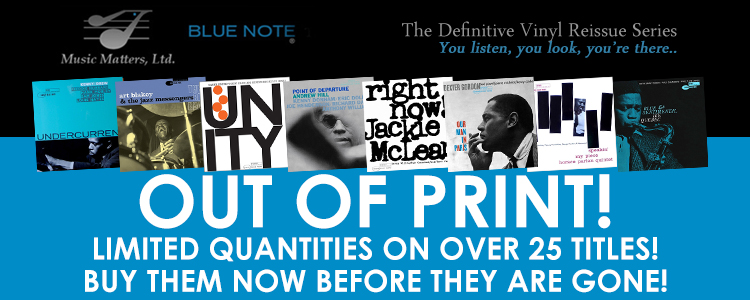
Oh, what the Hell? Maybe just a few more…
Early this year, after not hearing from him for a good eighteen months, Ron called me out of the blue. Very mysteriously, in his semi-surfer California patois, all he said was, “Dude. I’m sending you a box of test pressings. I’m not telling you what they are. Just listen to them and let me know what you think.” My interest was piqued, of course, especially since Ron had been adamant that he was done when the 33s were finished. I was pretty psyched three days later when UPS showed up at my office with a package. I drove home that evening still not knowing what records were in the box, but I’d planned on checking them out that evening. I hadn’t even pulled into my garage before the phone rang again, “Hey man, did you listen to the records?” I hadn’t, but whatever was in the box, Ron was clearly excited about them.
What was in that box?
Of the six 33 rpm test pressings, five of them were Blue Note titles that Music Matters had already issued including Song For My Father, Afro-Cuban, Adam’s Apple, Inner Urge, and Sonny Rollins’ Vol. 1, plus a new addition, Lou Donaldson’s Blues Walk; all magnificent performances to be sure.
It struck me as a risky choice to re-do so many records that Music Matters had already pressed when there are still so many un-reissued titles that might prove to be of novel interest to customers. But this goes back to the earlier point about making concessions to commercial viability. You have to be able to sell the records, and Ron went with consistent sellers.
SRX Vinyl
 After finally speaking with Ron it turned out that the impetus for pressing more records was a technical improvement in the vinyl itself. The material, which Music Matters is calling SRX, is designed to be a higher resolution medium. Ron believes that there’s more information and better sonic reproduction to be had with this stuff, making the investment worthwhile for his customers many of whom are audiophiles seeking the best sound possible.
After finally speaking with Ron it turned out that the impetus for pressing more records was a technical improvement in the vinyl itself. The material, which Music Matters is calling SRX, is designed to be a higher resolution medium. Ron believes that there’s more information and better sonic reproduction to be had with this stuff, making the investment worthwhile for his customers many of whom are audiophiles seeking the best sound possible.
Holding one of the records in front of a lamp revealed one new feature: unlike ordinary black vinyl these records are translucent; not in a gimmicky Fantasy red-vinyl kind of way though. They’re a practical shade of brown – the color of dark coffee. They allow a little light to pass through, but they’re certainly not designed to be visually extravagant. Not a dramatic difference, I thought to myself, but certainly not the same old thing either.
Although the exact formula is protected, the chemical changes are said to be significant. It’s claimed that new vinyl is a more highly refined than the stuff we’re all used to, and that all of the carbon has been omitted to reduce granularity in the playing surface. It’s also more difficult to work with. The tailings – the excess portion that’s cut off the edges of the record after pressing while the vinyl is still warm – cannot be re-circulated into the vat to press more records. It’s a one-shot virgin-vinyl deal. Ron claims it takes an entire pound of material to press one 180g record (about 0.4 lb. English). That’s a lot of waste that results in significantly higher production costs at about $8 per record just for the raw material.
With those kinds of unique production inefficiencies this material is likely to remain a specialty reserved for high-end audiophile reissues. The abysmal thirty-three percent yield ratio simply makes the stuff impractical for mass-market pressings.
The Music…Matters
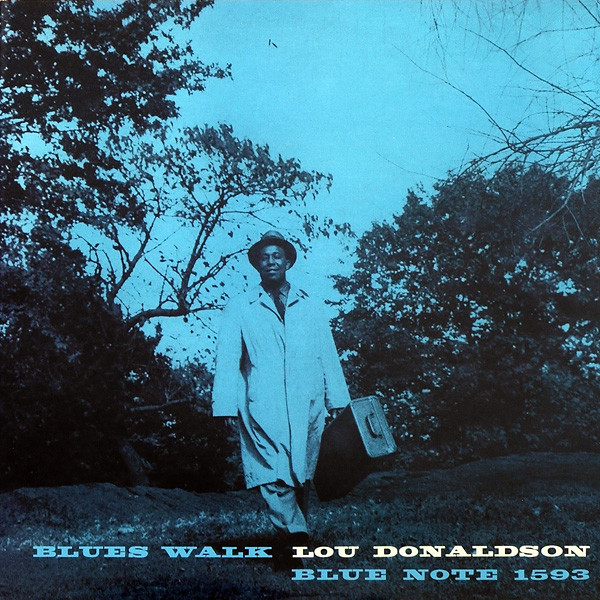 The world does not need yet another review of Blues Walk, so I’m not going to bore you with one: it’s awesome, if you’ve never heard it go listen to it, ‘nuff said. That’s true for all of these records. Every title in this set was a bona fide masterpiece the day it hit the street half-a-century ago.
The world does not need yet another review of Blues Walk, so I’m not going to bore you with one: it’s awesome, if you’ve never heard it go listen to it, ‘nuff said. That’s true for all of these records. Every title in this set was a bona fide masterpiece the day it hit the street half-a-century ago.
But the performance of the new vinyl itself is worth discussing because it does indeed offer some new qualities. In some ways, these test pressings obviously surpass the older series – and most other available records – starting with noise. Dropping the needle onto the first record it’s immediately clear that the noise floor has been significantly lowered, with almost no background surface grunge unless the volume is turned way up. It’s as close to the best dead-silent Japanese records as I’ve heard, a trick we’ve rarely been able to match with US pressings. Not that the older Music Matters titles suffered with respect to noise – they’re quiet – but whatever this new formulation is, it simply does a better job at rejecting background nasties.
The records also seem to have a smoother playing surface, with the stylus gliding through the grooves as if they’d been lubricated. It seemed like a ridiculous idea at first blush, but before anyone inquires on behalf of his or her delicate diamond, I asked – nothing has been applied to the surface of the records. If you’ve bought an expensive new pressing lately and found a scruffy, noisy piece of plastic, you know how frustrating that can be. These records are a refreshing change from that nonsense.
Of course, no one throws on a record to listen to the silence of the dead wax*. It’s what comes next that counts, and these records offer something new here as well, though the improvement is subtler than the obvious noise-reduction and may require some sophisticated equipment to realize its full potential. Simply, in my system this vinyl delivered improved refinement, dynamics, and liquidity, making them among the most highly resolved pressings I’ve spun on my turntable and certainly the most detailed I’d ever heard on any of these recordings. I’ll readily concede that there is a lot of lofty hyperbole in Hi-Fi describing what may be at best small incremental improvements in sound, so I want to reiterate: the improvements I heard are subtle, but they’re also real, and honestly with certain recordings, like Wayne Shorter’s Adam’s Apple, they’re not that subtle.
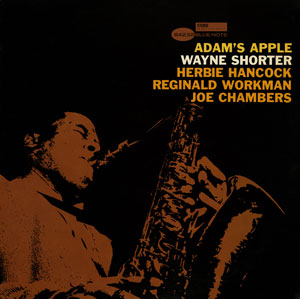 On the title track of Adam’s Apple those improvements were manifest as deeper stage depth and an actual sense of reverberating space around the piano on the most vigorous passages – something that can be a rarity on Van Gelder recordings (and not to be confused with artificially introduced reverb). The piano is what it is – the infamous Van Gelder piano with its variably truncated scale and dynamics – but even the keys fare quite well on this pressing. The cymbals pop and sizzle with no trace of hardness or treble glare even at high volume. The horns and drums are still hard panned – that’s just the way the album was recorded – but even placed directly in front of the speakers the instruments reveal improved dimensional solidity and mass and, most importantly, realism. The frequency extension at both ends of the spectrum is remarkably clean.
On the title track of Adam’s Apple those improvements were manifest as deeper stage depth and an actual sense of reverberating space around the piano on the most vigorous passages – something that can be a rarity on Van Gelder recordings (and not to be confused with artificially introduced reverb). The piano is what it is – the infamous Van Gelder piano with its variably truncated scale and dynamics – but even the keys fare quite well on this pressing. The cymbals pop and sizzle with no trace of hardness or treble glare even at high volume. The horns and drums are still hard panned – that’s just the way the album was recorded – but even placed directly in front of the speakers the instruments reveal improved dimensional solidity and mass and, most importantly, realism. The frequency extension at both ends of the spectrum is remarkably clean.
Lou Donaldson’s Blues Walk was the same story. Music Matters hadn’t cut this in the earlier series, so I used another company’s expensive reissue for comparison. In any form, this is an exceptionally good monaural recording, but pressed on the new SRX vinyl the sonic image acquires newfound scale; dynamism, height, and again, mass. The image on the other pressing was distinctly smaller and the sound more reticent. But the improved detail that stood out the most on SRX wax was the bass. In my system it’s fuller, deeper and punchier than the other pressing. More importantly, the under-tones of wood resonance and string vibration are more clearly enunciated and more realistic, something that can be difficult to discern on a mono record where all the instruments are layered over each other. It’s a small but significant detail – the difference between a decent pressing and really, really good one. Improved bass response proved to be one of the common threads running through all of these records.
Now, I wouldn’t want to suggest in any way that first two series of Music Matters releases were comparatively uninspiring – far from it. They’re among the best pressings – very quiet and sonically excellent – that I’ve experienced. As a group they’re one of the jewels in my record collection. But the new pressings seem to offer a little more of almost everything. The possible exception, and it’s not consistent across either series, is the soundstage. The 45s, with their wider grooves, may retain an edge in the scale of the presentation on some recordings, but not by much, and there are other refinements that make up the difference.
This leads me back to my earlier comment about equipment. I’m running a pretty expensive moving-coil cartridge played through an even more expensive phono stage, amplification, and speakers. Writing this article, I rather wished I still had my old $99 Shure M97Xe moving magnet on hand to see if the more basic cartridge could detect the improvements. Alas, it’s long gone. My guess is that a system running an inexpensive cartridge and modest electronics might not be resolving enough to reveal the sonic goodies on the new records when compared directly to the older pressings. The sonic goodies are definitely there, but it would be wise to consider the capabilities of your analog chain before you race out to replace any records you already have.
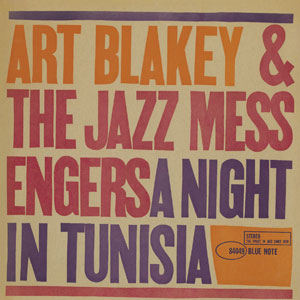 On the other hand, if you do have the equipment to wring out those details, well, that’s another story. The first actual release pressing on the SRX vinyl I had the opportunity to hear was Art Blakey and the Jazz Messengers’ A Night In Tunisia featuring Lee Morgan on trumpet, Wayne Shorter on tenor, and Jymie Merritt on Bass. The title track on this record is LOUD, opened by Blakey who pounds his kit into pulp – truly among the most dynamically recorded drumming one is likely to hear**. The thing that’s interesting about it though, is how the wax brings out the nuance around the skins: the reverberation in the studio bouncing off the wall behind the kit and the spread of the rapping blocks in the intro. There is nothing in any way delicate about Blakey’s work, but the reproduction of his drumming is nevertheless notably refined, shining light on small audible nuances – vibrations, space, and transparency – that might seem inconsistent with such a violent performance.
On the other hand, if you do have the equipment to wring out those details, well, that’s another story. The first actual release pressing on the SRX vinyl I had the opportunity to hear was Art Blakey and the Jazz Messengers’ A Night In Tunisia featuring Lee Morgan on trumpet, Wayne Shorter on tenor, and Jymie Merritt on Bass. The title track on this record is LOUD, opened by Blakey who pounds his kit into pulp – truly among the most dynamically recorded drumming one is likely to hear**. The thing that’s interesting about it though, is how the wax brings out the nuance around the skins: the reverberation in the studio bouncing off the wall behind the kit and the spread of the rapping blocks in the intro. There is nothing in any way delicate about Blakey’s work, but the reproduction of his drumming is nevertheless notably refined, shining light on small audible nuances – vibrations, space, and transparency – that might seem inconsistent with such a violent performance.
The soundstage on this record is enormous and everyone is playing balls-to-the-wall (wall-to-wall balls to the wall, if you will). The horns take their turn in mercurial creative bursts, teetering on the edge of the music’s framework, threatening to go straight over the edge. Then they hand it off to Merrit, and here again the record impresses. The solo bass is so full, so woody and so well articulated that it stands out in high relief in front of the piano. The first time I heard it I looked up, listened hard, then got up and played the record again just to be sure of what I’d heard. My ears hadn’t deceived me. It’s among the most well-articulated, perfectly captured bass recordings I’ve experienced in the Blue Note catalog, and its reproduction on this SRX vinyl is outstanding.
33 1/3 RPMs of Awesomeness
As I write this, I’ve not seen a finalized list of the records being released, but it’s likely to lean towards proven sellers with some excellent new titles that Music Matters hadn’t done in the first go round. It would be great to hear more new titles, of course, but sitting stock is the kiss of death and some business decisions had to be made. Notwithstanding, if past-experience is any guide it’s safe to bet that every title will be handled with the utmost attention to production values and packaging, offering a very special listening experience.
Based on the records I’ve listened to so far, I’m pretty excited about these new pressings. There’s always a place in the world for better records, and at the risk of offering an endorsement before I’ve heard all of them, if the next bunch of SRX Vinyl is as good as these test pressings they’ll be exceptional.
Many years ago, while writing my first article about Music Matters, I did an interview with Joe Harley. I asked him an obvious question, “Do you have a favorite title?” His answer was as good as any I’ve heard since, “My favorite record is always the last one I listened to.” I’m having that same experience right now with this new series of Music Matters records on the very promising new SRX vinyl formulation. This could be great stuff!
The Music Matters team are not only music lovers, they’re audiophiles as well. We asked them to share the equipment they use in their own homes and what they’re looking for when building system.
Joe Harley, Record Producer and VP of AudioQuest
ST: What equipment do you use in your home system?
JH: My home listening system consists of the following components: Vandersteen Model 7 speakers, Ayre MXR-Twenty amplifiers, Audio Research REF-6 Preamp, Audio Research REF 3 Phono Stage, Basis A.J. Conti Transcendence Turntable, Lyra Atlas stereo cartridge, Lyra Atlas mono cartridge, Aesthetic Romulus DAC/CD player, AudioQuest Niagara 7000 power conditioner, AudioQuest interconnects, power cables, digital cables and speaker cables, Silent Running Audio racks.
ST: Which piece do you think is the most important piece in your signal chain?
JH: That’s a tough question. Everything works together as a system so eliminating any single part means the whole ceases to work properly. I suppose in one sense you could view the preamplifier as the heart of the system since it’s the gatekeeper for all of the other source components.
ST: With MM being a vinyl reissue house, what turntables, arms, and cartridges do you prefer and why?
JH: Of course I’m quite taken with my Basis Transcendence turntable (photo attached) for several reasons. Most importantly, it’s the first turntable/arm where I can barely hear that there is a mechanical interface. The resultant sound I get from this turntable rig is closer than I ever thought possible to the sound of analog tape. It’s freaky good! Also, A.J. Conti personally set the table up for me. As far as I know it was only Transcendence model he set up, aside from his own, before he passed away shortly after visiting me to do the set up. I miss A.J. and thank him every time I listen to that table, which is every day.
ST: Do you have a separate turntable set up for monaural playback of vintage records, and if so what is it?
JH: I don’t have a separate turntable for mono but I do have a separate Basis Superarm that carries a Lyra Atlas mono cartridge. Ron and I have reissued many classic Blue Note mono LPs and there’s nothing quite like hearing a mono LP played back via a mono cartridge. Mono y mono baby!
ST: What’s the oldest piece of equipment in your system and why have you kept it around?
JH: The oldest piece of gear in my system would be the pair of Vandersteen Model 7 speakers. I keep them around because I know of no better “truth teller” when it comes to high-performance loudspeakers. Being involved in so many original productions as well as reissues means having to know exactly what the mix is doing, or the test pressing is telling you about the mastering. Put simply I would be lost without my Vandy 7s. They are my professional ears. (And they’re also damn fun to listen to!)
ST: Do you have any favorite budget pieces?
JH: I actually do have a favorite budget piece. This may come across as self-serving but it’s true. The AudioQuest DragonFly Red portable DAC has proven to be a godsend when I’m on location and need to check on a digital mix. This thing is crazy good and it’s only $200 bucks!
ST: Other than great sound, are there any other major considerations in the evolution of your system?
JH: Of course I want the rig to be highly pleasurable to listen to but it also has to tell me the truth. Nothing is perfect of course, but this rig comes closer than anything I’ve had in the past. At 66 I’ve had many different rigs going back to the KLH portable system I had in the late 60s when I was in high school.
ST: Do you have any favorite tweaks?
JH: These aren’t tweaks per se, since they would fall under the category of record care, but I find my Audio Desk Pro ultrasonic LP cleaner to be invaluable for knowing exactly what is on a vinyl record. This becomes critically important when evaluating test pressings. You don’t want to be making comments about mold release or crud in the grooves (which eventually gets removed by playing) when reporting back to the pressing plant. The other thing I use with every single play (and it will sound self serving again … sorry) is the new version AudioQuest Anti-Static Record Brush.

Ron Rambach
ST: What equipment do you use in your home system?
RR: TW Acoustic Raven Turntable with two Raven 14” arms, a Lyra Atlas stereo cartridge and a Dynavector Mono on the back. I have a combination of AudioQuest Cables and an AudioQuest AQ 5000 power supply. Amplification is Jimmy White’s Aesthetics Atlas Amps with an Audio Research Ref 6 preamp and a Ref 5 phono stage. My speakers are Vandersteen 5A with the carbon tweeter mod.
ST: Which piece do you think is the most important piece in your signal chain?
RR: The records, the number one piece. Your system will only sound as good as your records, then cartridge and tonearm with perfect setup.
ST: What’s the oldest piece of equipment in your system and why have you kept it around?
RR: I’ve had the Atlas Amps the longest. The Vandies are really power hungry and the amps are capable of driving them with slam and grip, and they’re very three-dimensional.
ST: Do you have any favorite budget pieces?
RR: Anything Dynavector makes. X20 cartridge. If it’s good enough for Richard Vandersteen…
ST: Other than great sound, are there any other major considerations in the evolution of your system?
RR: I’m looking for musical cohesion, slam, air, and sculptural three-dimensional wrap around, anything that furthers the illusion of the recording space. No system will ever sound like live acoustic music, but I want it as real as I can get. I want to hear the brass, spit, oil etc.
ST: Do you have any favorite tweaks?
RR: I’ve got Silent Running equipment racks. The AQ 5000 power conditioner really drops the noise floor on my other gear. It’s got just pure power and current stability. Noise creates smear and robs you of the inside of the music. The AQ-5000 eliminates noise you didn’t even know you had. Also, I have an Audio-Desk Pro ultrasonic record cleaner, which is indispensible.


greg simmons
Foot (In Mouth) Notes
*The Silence of The Dead Wax is a new motion picture starring Sir Anthony Hopkins as a cannibal record collector dining on music executives who’ve pressed inferior vinyl, a meal accompanied by some fava beans and a nice Chianti. Also featuring Don Was as ‘Liver’.
**While this Blakey version is certainly powerful, I’m generally of the opinion that there was absolutely no reason for anyone to ever play “A Night In Tunisia” again after Charlie Parker played the break on the original Dial Label recording. This includes the song’s composer, Dizzy Gillespie, who nevertheless insisted on performing it for decades anyway. In that moment in 1946, Bird produced a perfect, unmatchable improvisational statement, eclipsing anything anyone has played in that space since. This is my completely unqualified opinion, of course. Your take on it may vary.
Specifications (Well, ok, if you insist)
They’re round
They’re flat
12”, 180g, 33 1/3 RPM LP Records
Associated Equipment:
Digital Front End
Cambridge 840C CD player used as a DAC
Cambridge CXC CD Transport
Amplification
Cary SLP-98P preamp w/ MM phono stage
Cary CAD 280 SA V12R power amplifier
Turntables & Tonearms
SOTA Star Sapphire, Series III turntable
Rek-O-Kut T12h turntable
Technics 1200 Mk 1 turntable
Jelco 9” SA-750 DB toneam
Karmadon 12” viscous damped unipivot tonearm
Calrad SV-16 12” viscous damped unipivot tonearm
Phono Cartridges
Lyra Delos moving coil cartridge
Audio-Technica OC/9-III moving coil cartridge
Audio-Technica AT33Sa moving coil cartridge
Miyajima Spirit Mono moving coil cartridge
Phono Amplification
Aurorasound SP-03H stepup transformer
Lyric Audio PS-10 MC/MM phono stage
Loudspeakers
Verity Audio Fidelity Encore
Magnepan MG-IIA
Cabling
Audio Quest Copperheads
Zentara Reference ICs
Zentara Reference Speaker Cables
Nordost Blue Heaven ICs
Cullen power cords
MIT Z-Cable power cords
Accessories
Tice Box power conditioner
Nordost Sort Kones AC vibration dampers
Mapleshade Audio Rack
Stereo Times Masthead
Publisher/Founder
Clement Perry
Editor
Dave Thomas
Senior Editors
Frank Alles, Mike Girardi, Key Kim, Russell Lichter, Terry London, Moreno Mitchell, Paul Szabady, Bill Wells, Mike Wright, Stephen Yan, and Rob Dockery
Current Contributors
David Abramson, Tim Barrall, Dave Allison, Ron Cook, Lewis Dardick, Dan Secula, Don Shaulis, Greg Simmons, Eric Teh, Greg Voth, Richard Willie, Ed Van Winkle, and Rob Dockery
Music Reviewers:
Carlos Sanchez, John Jonczyk, John Sprung and Russell Lichter
Site Management Clement Perry
Ad Designer: Martin Perry







Be the first to comment on: Music Matters: SRX High Definition Vinyl